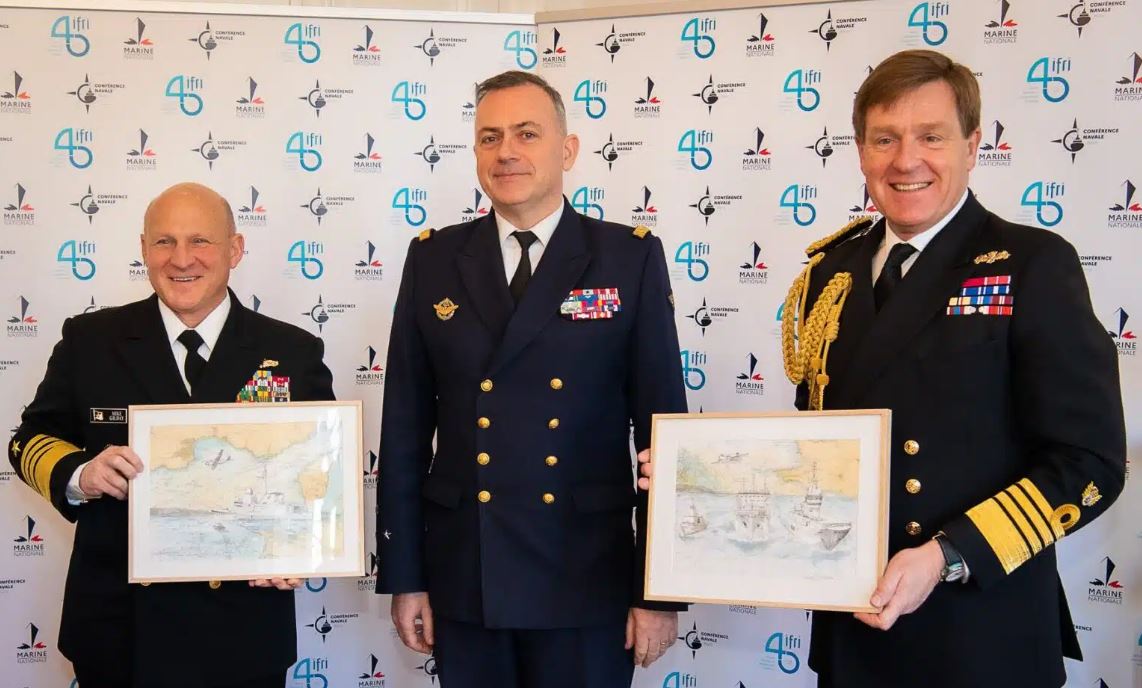US Navy, French Navy And Royal Navy See Eye To Eye On Interoperability
The heads of the three leading NATO navies, the Chief of Naval Operations (CNO), Admiral Mike Gilday, First Sea Lord, Admiral Ben Key, and the Chief of Staff of the French Navy, Admiral Pierre Vandier, met last week in France for the first ever "Paris Naval Conference".

Organized by Ifri and the French Navy, the theme of the conference was “the return of naval combat”: The world has entered a new strategic cycle, characterized by the assertion of new powers eager to revise the international order, the predominance of unilateralism, and the increased risk of confrontation between States. In such a context, naval combat appears as a plausible hypothesis that can arise in the context of a high-intensity conflict.
Interoperability and Interchangeability
During a press conference held at the end of the conference, Naval News asked the three head of navies to share their vision of what interoperability and interchangeability is, and if this means “procuring the same piece of kit”.
Admiral Sir Ben Key answered first, explaining that to his mind, interoperability doesn’t mean procuring the same piece of kit “because in doing so, we lose resilience, and we lose broader innovation. And one of the themes of the conference has been about the need to adapt at the speed of relevance”.
Interoperability and interchangeability means to me two things, one, that we have a flow of ideas moving very seamlessly, where we can set to one side some of the traditional senses of classification, so that the practitioners can continue to communicate and share their thinking at the front edge of the leading edge. National concerns about protection of information between militaries are set as much as possible to one side, because as Admiral Vandier has made it very clear in his presentation, it is the ability to operate at a quicker cycle of decision making, than the adversary, that is absolutely key to being able to secure operational advantage. That is not to say that we shouldn’t be able to operate in close company with each other.
We continue to invest in opportunities where our ships can operate and move between international task groups. Without any said loss of capability for the commander. It means, as we have seen, between myself in 2021, that we had United States F-35s fly from HMS Queen Elizabeth. And we have also seen American and French jets operating from each other’s carriers. And we do that with confidence not just to take a photograph, but actually because you can deliver warfighting and that gives commanders enormous flexibility. That is the kind of tactical manifestation of interchangeability, that interoperability, which is a loosely defined term, is actually that we can move collectively faster than our adversary, Admiral Sir Ben Key, First Sea Lord, Royal Navy
Admiral Pierre Vandier then shared his vision of interoperability, explaining that warfare is a continuous process.
“You have new assets, you have new technology, new procedures, new tactics. So, because we do not work each day together, but we encounter each other, we share things. So the process is first to develop things, you know, then to let the others know, and share and confront and see if it’s feasible to do things together. And then [the next step is] to establish standards, technical and operational standards, especially the procedures. So it’s much more than buying or building something together, it is employing together capabilities, which are a one day, at one stage of their development fitted to be interoperable. And so they can be plugged in. But the plug is not just mechanical or digital, it is a concept plug. We then can operate on the same theatre. Keep in mind that the naval forces, the width of their deployments spreads over thousands of kilometers. We are not all the time we are on the same net, in the same combat, but the strategic and operational effects have to be synchronized. And this is interoperability.” Admiral Pierre Vandier, Chief of Staff , French Navy
Admiral Mike Gilday used a real life and current example of where interoperability mattered: Prosecuting Russian submarines:
“One other aspect of that is the step above the tactical to the operational level, where our staffs can operate together seamlessly as well. Sometimes it happens quickly, when you step into crisis or conflict, our staff have to be able to work together well. So I would point to examples, like most recently, our work together in the prosecution of Russian submarines. So we do that with a very, very high degree of professional competency. And we do that not only because for all the reasons that the admiral stated at the tactical level, but also at the operational level. Another very good example of that was the strikes against Syrian chemical facilities a few years ago, where those strikes were primarily executed from the maritime [side], they were done with precision and they were done with a very high degree of collaboration across the nations that are present [here today].” Admiral Michael M. Gilday, Chief of Naval Operations, U.S. Navy
[...]
> Read the article on Naval News.

Media:

Share




